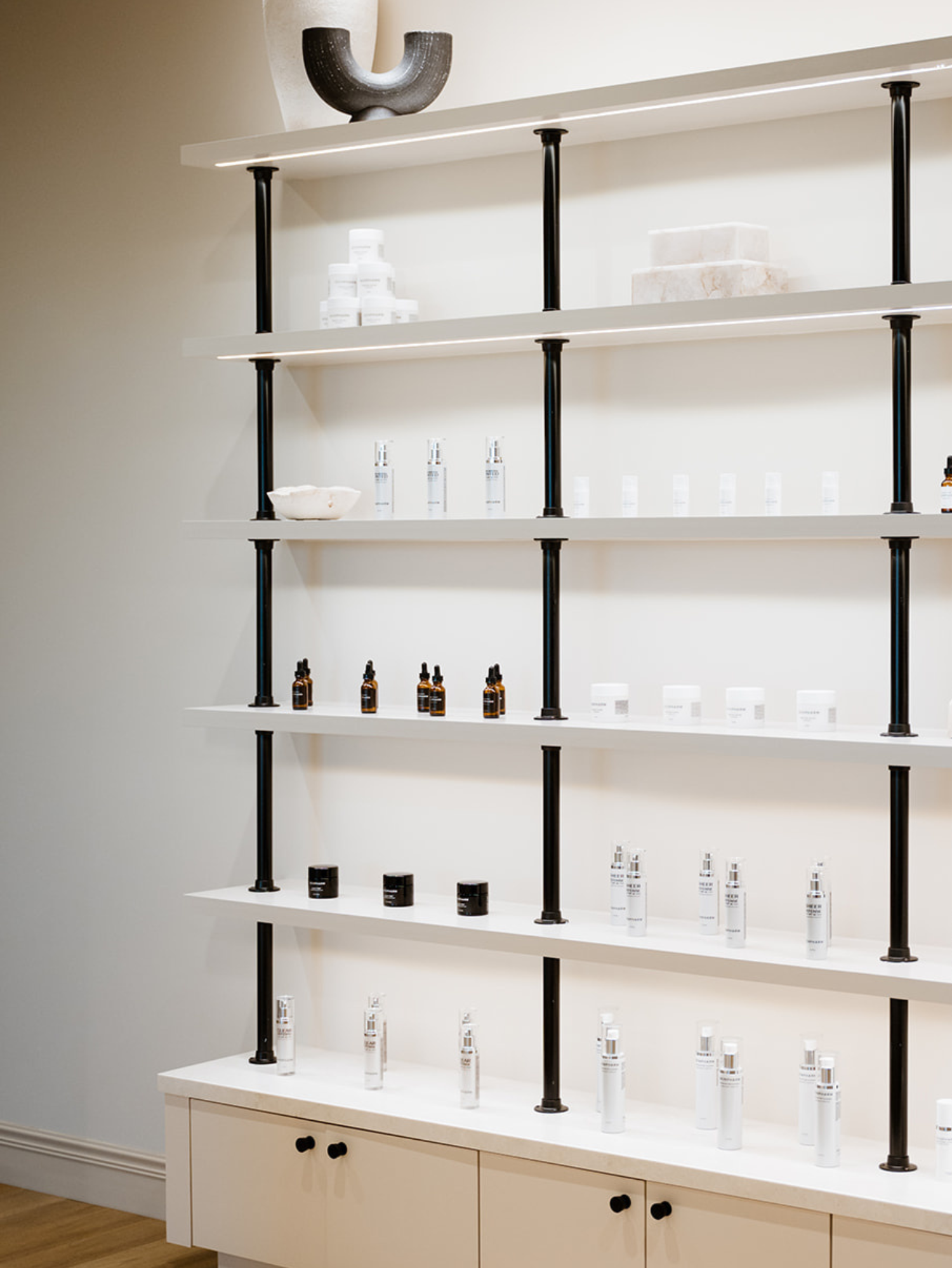Shop skin care
Clinics
VISIT OUR 12 CLINICS →
HOURS
Monday – Friday
9:30a – 5:30p
How to Use Vitamin C and Retinol in Your Skin Care Routine
by Anna Kate Read October 03, 2021

As far as skin care combinations go, vitamin C and retinol are a powerhouse duo.
If you’re looking for ingredients that can overhaul your skin, this one-two punch may be just the thing for you.
Combining vitamin C and retinol effectively to make the most of both components is essential, though, so you don’t minimize the benefits of either. Skin Pharm has products that feature both vitamin C and retinol, and we’ll go through the best way to incorporate them into your routine.
Vitamin C basics and benefits
Vitamin C, or L-ascorbic acid, is a water-soluble vitamin considered to be essential to the body. It has a reputation for being an immune system booster, and people often turn to it when they’re feeling under the weather.
You may be familiar with vitamin C as a component of many fresh fruits and vegetables we eat, especially citrus fruits like oranges. But vitamin C can do so much more than just taste great and potentially fight off the common cold.
When it comes to the skin, vitamin C is one of the more well-rounded skin care ingredients out there. Most of its benefits are related to its antioxidant properties. Free radicals, which are rogue molecules lacking an electron, can cause significant damage to the body without protection. Antioxidants take one for the team, either donating or sharing an electron to help neutralize free radicals.
Vitamin C is also an essential part of the collagen synthesis process. Collagen is the component of the skin that keeps it looking firm and youthful (along with elastin), so this is a crucial benefit.
As we age, the body naturally begins to slow down its production of this essential protein. Combined with the fact existing collagen begins to break down, especially in the face, collagen loss accounts for many of the age-related complaints most people experience.
With those things in mind, here are some of the more common benefits of using topical vitamin C:
- Combats hyperpigmentation/dark spots
- Evens skin tone
- Improves the appearance of fine lines and wrinkles
- Brightens the complexion
- Hydrates the skin
Retinol basics and benefits
Next up is retinol, a derivative of vitamin A. Some retinoids are over the counter, while others require a prescription from your skin care provider. Retinol shares some benefits with vitamin C, although each ingredient works differently.
Retinol works by helping to increase the rate that the body can create and turn over new skin cells. What that means for your appearance is that your face is always showing the most youthful skin possible, which is often far more radiant and smooth.
That process can also keep more water inside the skin, increasing your hydration. Retinol also helps exfoliate to constantly clear off the dead skin cells from the skin’s surface.
Retinol can also help to trigger an increase in the production of collagen. That’s why so many consider it to be such an effective anti-aging skin care ingredient. This helps plump and firm the skin, leading to a decrease in the visibility of fine lines and wrinkles.
Retinol can effectively minimize the number of blemishes you experience, too. It does this by helping to regulate the production of sebum (the skin’s natural oil), which is a frequent clogging agent that can lead to breakouts.
Here are a few of the benefits that people can experience with topical retinol use:
- Clears pores
- Reduces breakouts
- Fights visible signs of aging (fine lines and wrinkles, sagging, etc.)
- Evens the skin tone and reduces hyperpigmentation/dark spots
- Brightens the skin
The only potential drawback of retinol is that it can irritate and dry out the skin, especially for people prone to sensitivity. People with sensitive skin can still use retinol but only in moderation to avoid further dryness or skin dulling.
What factors into combining vitamin C and retinol?
Unfortunately, there are “wrong” ways to combine vitamin C and retinol. If you aren’t aware of the best practices of using both ingredients, you may inadvertently make both less effective.
You can’t just layer them on top of each other like you can with many of the other skin care ingredients out there. When it comes to effectively combining them, it comes down to two different factors – pH and solubility.
PH
pH is the first important factor to take into account. Much like the skin has a specific pH (usually around 5.5, which is slightly acidic), water-based skin care products also exist on that same scale. However, different skin textures might alter your pH balance — for instance, oily skin tends to be more acidic, resting between 4 to 5.2.
When they are created, skin care companies design them to work optimally in a small pH range. Skin care products that aren’t water-based, which we call anhydrous, don’t have a pH.
Vitamin C, and more specifically L-ascorbic acid (its active form), requires a lower pH than the skin. To effectively penetrate the skin, products that include vitamin C need to be at a pH of 3.5 or lower.
Retinol, on the other hand, works best at a pH closer to the skin. That pH is usually between 5.0 and 6.0 and tends to be the same across the board – retinol, retinoids and retinol esters.
Obviously, with a pH scale that only spans from 0 to 14, a gap of 2 is relatively significant. That means that using them too closely together can either raise the pH of the vitamin C or lower the pH of the retinol, which would theoretically make them less effective. However, recent studies prove that both ingredients work together, despite the possibility of shifting pH balances. In fact, vitamin C stabilizes retinol, which actually makes it more effective in its anti-aging properties.
SOLUBILITY
The second factor to consider is the solubility of the ingredients — whether they are oil-soluble or water-soluble. Solubility refers to the ingredient’s ability to dissolve and what type of solution dissolves it the best. Oil-soluble ingredients dissolve better in oils, and water-soluble ingredients do best in water.
Vitamin C is water-soluble, while retinol is oil-soluble. Because oil and water can’t mix, using them together without making certain concessions can lead to clashes where neither ingredient can dissolve into the skin. That is especially true when you use an oil-soluble component first, as it can create a barrier on the skin that stops water-soluble components from getting through.
The best ways to use vitamin c and retinol together
There are a few options for how you can effectively use vitamin C and retinol together without losing either of their benefits.
USE EACH INGREDIENT AT SEPARATE TIMES OF THE DAY
The first option you have to combine vitamin C and retinol is to use them at separate times of the day. Specifically, it’s best to use vitamin C in the morning and retinol at night. The reason for that has a lot to do with how each ingredient works.
Vitamin C is an effective antioxidant and may have sun-protective properties, so using it in the morning can boost your ability to limit potential damage from UV radiation. A quality vitamin C-based serum, like Skin Pharm’s Glow Factor, helps guard your skin against other environmental factors as well.
Alternatively, retinol is an ingredient that can increase sun sensitivity and increase the likelihood of sunburn or UV damage. It is also sensitive to UV light itself, making it less effective. Using it as part of your evening routine is the best option so that it can work its magic while you sleep. Skin Pharm’s Night Watch serum, formulated with 0.2% retinol, is excellent in this context.
Incorporating sunscreen into your daily skin care routine is another way to avoid sun damage. Retinol is a highly effective ingredient, but the increased risk of sun sensitivity shouldn’t be taken lightly. Use SPF and stick with a light, nighttime retinol serum to shield your skin against sun damage and skin aging (especially if you already have a sensitive skin type).
USE EACH INGREDIENT ON SEPARATE NIGHTS
If you prefer to use your heavy-hitting skin care ingredients at night, effectively combining vitamin C and retinol is still a possibility. While vitamin C is at its best as part of your morning routine, it is still just as powerful in the evening.
However, that doesn’t mean that you can use them both at the same time. It’s often best to alternate the ingredients, using them on different evenings. We especially recommend an alternating skin routine if you’re prone to dry skin or other sensitivities. Your skin is already hyper-sensitive to active ingredients, so it’s best to proceed with caution regarding vitamin C and retinol since they’re especially strong.
PUT SOME TIME BETWEEN INGREDIENT APPLICATIONS
If you’re determined to use vitamin C and retinol together in the same routine, you’ll need to make sure to put enough time between them. It’s also essential to apply your vitamin C first because it has the lower pH of the two ingredients. Use a gentle cleanser first and then apply your vitamin C product (ideally a serum).
Thirty minutes seems to be the optimal amount of time to wait between applications. That allows your skin to return to its normal pH so that it can be ready for the next ingredient in your routine. Once you’ve allowed that time to pass, you can apply your retinol-based serum or lotion. While that can extend the time required to get ready for bed or in the morning, it’s worth it to make sure that your skin care routine is working for you.
To wrap things up...
Vitamin C and retinol are effective ingredients alone and can be a true powerhouse duo when combined. Learning more about how each of them works can help you use them together for the best results possible.
A proper skin care routine is essential to achieve your skin goals, and Skin Pharm would love to help you find one that's right for you. Book a skin consult with one of our providers today to get started!
This article was medically reviewed by Chelsie Rogers, PA-C, a board-certified physician assistant with six years of experience in cosmetic dermatology.
SOURCES:
[Normal pH value of human skin] | PubMed (nih.gov)
Topical L-ascorbic acid: percutaneous absorption studies | PubMed (nih.gov)
Histological evaluation of a topically applied retinol-vitamin C combination | PubMed (nih.gov)



















